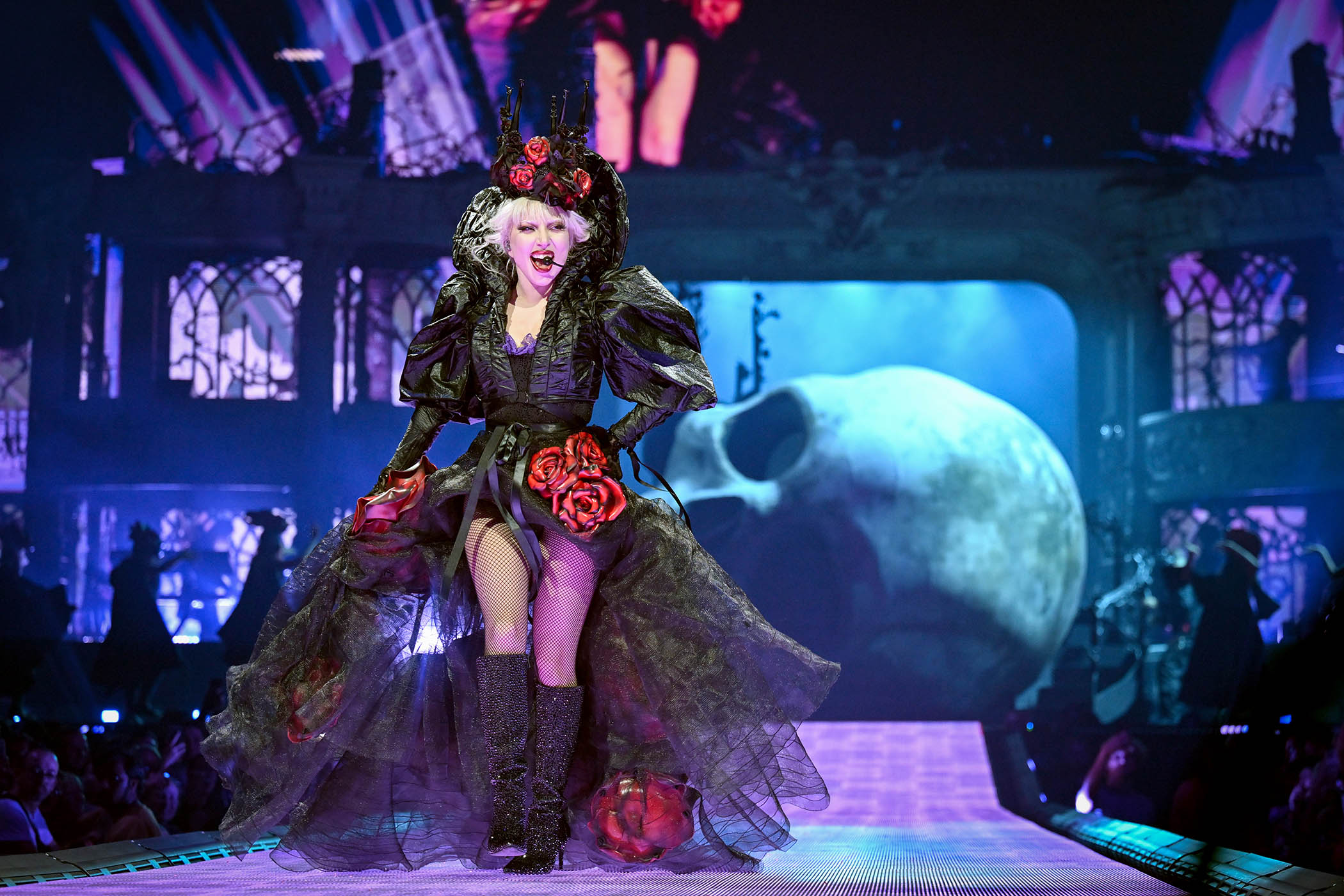Midway through her two-and-a-half-hour concert, Lady Gaga sings lying down in a mass grave. She might be in a medieval plague pit, given the scary, beak-masked doctors who appear at the show’s climax (they reanimate Gaga’s corpse). But who knows? The production’s aesthetic timeline moves around a lot. Gaga’s costumes channel Marie Antoinette – if she were dressed by Tim Burton. The mise en scène is a fever dream in which the cast of The Rocky Horror Picture Show stage The Phantom of the Opera. There are acts; the font is curlicued.
Gaga finds herself next to a skeleton with a rictus grin and serenades it, fondling it, then tries to kill it (again!). The track is Perfect Celebrity, from her latest album, Mayhem, released in March and a strong candidate for album of the year at the 2026 Grammys. Despite the song’s real anger, Gaga is fully in control of the camp, gothic absurdity in which the moment, and the rest of this extraordinary tour, luxuriates. “You love to hate me,” she sings. “Sit in the front row, watch the princess die!”
Haters are thin on the ground this evening, the final date of Gaga’s UK tour. But the American singer is a two-decade survivor of the changes of heart to which the public are susceptible; of the carnivorous appetites unleashed by celebrity.
More than anything else – dancing, say, or bad romances – Gaga’s primary topic is fame. Many of her records are about courting it, or wrestling with its contradictions. Her 2008 debut album manifested it, hard: Gaga wore huge dark glasses on the cover of The Fame, before anyone knew who she was.
As her career soared, then twisted and turned through jazz, country and cinema, a series of questions have thrummed alongside it. Is fame monstrous? Is the meat-wearing, theatrical Gaga the same person as her versatile creator, Stefani Germanotta? (Mayhem pictures Gaga next to her reflection in a cracked mirror.) And is mothering her fans – known as “Little Monsters” – worth tolerating the predatory tendencies of paparazzi and keyboard warriors?
More than anything else, Gaga’s primary topic is fame
These are not original questions. Taylor Swift is another modern auteur whose relationship with fame provides a bassline thrum to her output. But Gaga has more than one idiosyncratic spin on the topic, and many of them are in perpetual motion during her Mayhem Ball tour.
Mayhem went back to first principles after a stuttering few years in which Gaga’s profile wavered. Its songs, such as Abracadabra and Disease, knowingly recall her early hits. You wouldn’t, however, call it a back-to-basics move. The Mayhem Ball doubles down on everything most Gaga about Gaga, turns it up to 11 and then goes even further over the top.
The plot of this romp through her greatest hits and her high-octane comeback album is not always comprehensible, but it offers up an unrelenting dance remix of everything you could want from a Gaga set list. Arena tours have always been as much about hydraulics and flames and how many dancers you can conceivably stuff into a giant birdcage covered in a red tea cosy (the Mayhem Ball’s opening scene; the answer: many).
But this is up there with the biggest touring extravaganzas of the past couple of years – a novel, female-led, showbiz-on-steroids league that includes Swift’s Eras, Beyoncé’s Cowboy Carter tour and Chappell Roan’s own rococo layer cake of a summer romp.
Gaga’s performance is an almighty tussle between the warring impulses within the singer. Presented as a chessboard battle between red and white queens, it enacts her internal conflicts, caught between the chaos of life as a showgirl with a taste for the macabre, and the instincts that locate Germanotta in a more comfy, establishment place (the Tony Bennett duets, the national anthem-belting for Joe Biden).
Her struggles with the pain of fibromyalgia are woven into the images: she deploys crutches and walking sticks as props. It’s funny too: witness the furry, elongated Dr Seuss talons Gaga sports for an epic rendition of Bad Romance at the set’s peak. The drama ends with what a therapist might call integration: the two queens are, after all, one.
Just as Swift’s most recent album, The Life of a Showgirl, can be read as both a return to her own first principles and a goodbye to all that, so too with Germanotta, who is eyeing her own wedding and a possible career break. As How Bad Do U Want Me plays out, she ends the show stripped of her wigs and corsetry, a beanie hat on her head, her bare face mottled with tears, sweat and hastily removed makeup.
This kind of authenticity is its own kind of artifice, of course, but it’s salutary to see Germanotta looking knackered and emotional after presenting one pop’s most entertaining facades for so long.
Photograph by Samir Hussein/Getty Images

